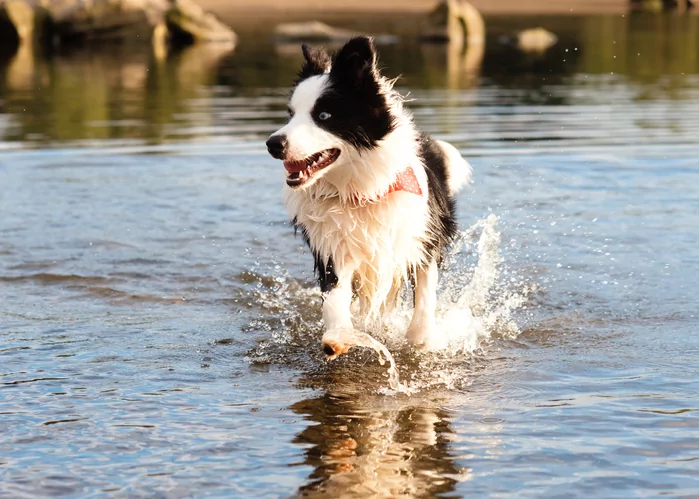Should You Let Your Dog Swim in Rivers and Lakes This Summer?
Are you planning on taking your dog to the river or lake this summer and want to know if it is safe for them to swim? If you are careful, taking your pup for a swim is a fun idea! Of course, the first thing you must do is make sure your canine knows how to swim. Read on to learn if you should let your dog swim in rivers and lakes this summer.

Water Safety Tips for Dogs
Swimming can be dangerous for dogs if the proper precautions are not taken. While you should not deprive your dog of swimming, you want to practice safety first. If you are planning to take your pup to a river or lake to swim, you need some water safety tips. The main tips to follow in Georgia are listed below:
Introduce Them to Shallow Water
Most dogs have some experience with swimming. You should teach your dog not to fear the water when they are between two and five months old. However, your pup may not know how to swim. Before you can take your dog to swim in a river or lake, you need to make sure they are comfortable in the water. Starting them at the shallow end of a pool is best.
Allow your dog to get their paws wet and acclimate to the water. Gradually move them to the deeper end, but if they are overwhelmed, take them back to the shallow end until they feel more comfortable. Take it slow and teach them that there is nothing to fear because you are by their side. They will likely come around and become natural swimmers.
Supervise Your Dog
Supervising your dog when in the water is essential to ensure their safety. This practice is especially true when they are in a river or lake. Remember that the colder the water is, the faster it will tire them out. Watch for signs of fatigue:
- Trembling
- Heavy panting
- Swimming slowly
- Swimming low in the water
Many dogs will keep themselves from experiencing over-exertion or becoming over-tired by stopping when they want to rest. Keep a close watch on your canine for any differences in behavior. Your pup will let you know when they have had enough.
Know How to Do Canine CPR
Performing CPR on pets is similar to performing CPR on humans. Gaining knowledge of pet first aid is a great way to ensure your dog is always safe with you. If your pup is struggling in the water, knowing CPR will keep you calm and able to help them. If you take your dog to the lake, have a plan of action in mind if your dog is drowning and how to prevent it.
Give Your Dog Fresh Drinking Water
Bring fresh, clean drinking water with you when your pup goes swimming. Swimming can be strenuous for them, and you must keep your dog hydrated. Bring a water bottle and bowl with your dog to get the water their bodies need. If you have some cool water, they will not be as tempted to drink water from natural sources that may contain harmful bacteria.
Below are signs your dog drank from a contaminated water source:
- Loss of energy
- No appetite
- Belly discomfort
- Vomiting or diarrhea
Giardia is a parasite and a serious concern. If your dog drank water from a lake or any other form of stagnant water, they could become infected with the illness. If your pup drinks from a river or lake that another animal has pooped in, they can get very sick. Bacteria like Salmonella, E coli, and Leptospira are also a threat. Never let your pup drink from a lake or river.
Have Them Wear a Life Jacket
If you are taking your canine on a ride in your canoe or boat, have them wear a doggie life jacket. Your dog can get into trouble if the canoe tips over, and the current may be too strong to swim against. A life jacket can help keep them safe. The life jacket should keep your pup’s head above water, and they should be able to move around comfortably.
Do Not Allow Your Dog to Swim Out Too Far
When you and your dog are at the lake or river, please do not allow them to swim out too far. Your dog can tire, the water can get deep, and your pup may struggle to stay afloat. Do not let your dog swim if powerful currents are in the water. They may be unable to pull themselves up from a current, and some currents are more forceful than what you see on the surface.
Steer Clear of Blue-Green Algae
Your dog should steer clear of water containing toxic algae blooms. It is blue-green in appearance and looks like there is slime on the surface. It is highly toxic to dogs, and there are some signs you must watch for:
- Panting
- Seizures
- Disorientation
- Vomiting or diarrhea
Ingestion of blue-green algae can lead to respiratory failure, liver failure, and even death. Your dog can swallow the blooms as they are swimming. If you see any signs above, get them to the nearest emergency vet immediately.
Keep Your Dog On a Leash
When you are around bodies of water, keep your dog leashed to protect them from potentially hazardous or contaminated water. You want to ensure the water is safe before you allow your pup to get near it.
Having your dog on a lead will also protect them from predators. You may want to keep your canine on a leash while they are swimming. If you let them loose, make sure they come when called. You can employ positive reinforcement, such as their favorite treats.
Protect Your Pup from Snakes
Keep your pup on a leash and close to you to protect them from snakes. It will help you prevent an encounter between a vicious snake and your dog. Snakes tend to hide in areas with tall grass. When you are in an area known to have snakes, do not allow your pup to swim. If your dog gets bit by a snake, go to the nearest emergency vet immediately.
Do Not Forget the Sunscreen and First Aid Kit
Remember the sunscreen and first aid kit when you pack your bag for the lake. Just ensure it is specifically formulated for dogs, as human sunscreen contains toxic ingredients. Your pup can get sunburned easily, and those with light-colored fur can be more susceptible. Apply sunscreen to sun-sensitive areas, like around the lips, tips of the ears, and belly.
First-aid kits are essential in case your pup is cut or wounded or has an injury. It should have the standard bandages and anti-bacterial ointment to treat your dog if necessary.
Follow these Safety Tips When Allowing Your Dog To Swim in a River or Lake
There is no reason why your dog cannot go swimming in a lake or river if you are extremely careful and keep a close eye on your pup. If you follow the safety tips in this article, you and your dog will have a “swimmingly” good time in the water! For more information, contact The Village Vets by calling one of our locations.
Recent Posts
About The Village Vets
The Village Vets is a network of animal hospitals based in Atlanta, GA and the surrounding area. We offer honest, excellent service to our clients in a comfortable, friendly atmosphere. To learn more about our locations and how we can better serve you and your pet, click the button below.
Share This Post
Recent Posts
About The Village Vets
The Village Vets is a network of animal hospitals based in Atlanta, GA and the surrounding area. We offer honest, excellent service to our clients in a comfortable, friendly atmosphere. To learn more about our locations and how we can better serve you and your pet, click the button below.



